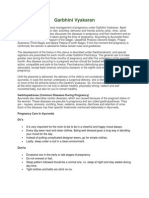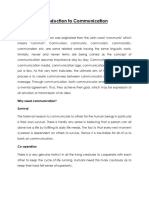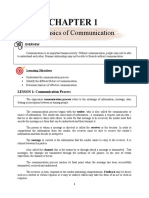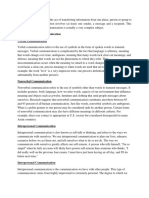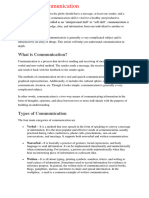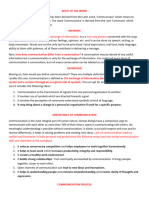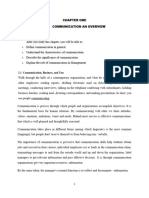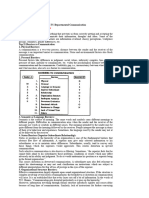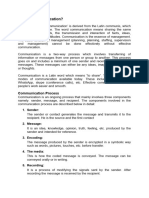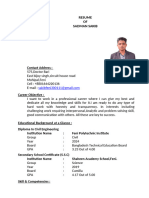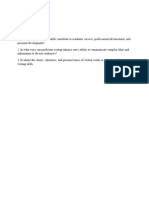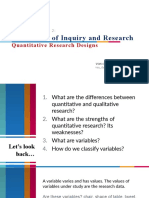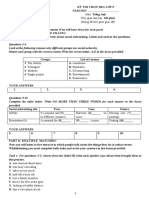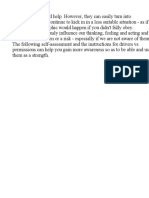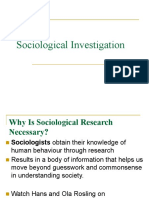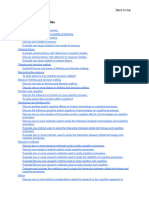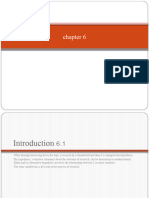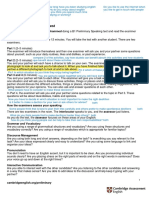0 ratings0% found this document useful (0 votes)
4 viewsCommunication 1st
Communication 1st
Uploaded by
nehagupta4915The document discusses the fundamentals of communication including defining communication, explaining the communication process and its importance. It also covers the differences between oral and written communication and barriers to effective communication such as linguistic, psychological, emotional, physical, cultural, organizational structure, attitude and perception barriers.
Copyright:
© All Rights Reserved
Available Formats
Download as DOCX, PDF, TXT or read online from Scribd
Communication 1st
Communication 1st
Uploaded by
nehagupta49150 ratings0% found this document useful (0 votes)
4 views8 pagesThe document discusses the fundamentals of communication including defining communication, explaining the communication process and its importance. It also covers the differences between oral and written communication and barriers to effective communication such as linguistic, psychological, emotional, physical, cultural, organizational structure, attitude and perception barriers.
Original Title
communication 1st
Copyright
© © All Rights Reserved
Available Formats
DOCX, PDF, TXT or read online from Scribd
Share this document
Did you find this document useful?
Is this content inappropriate?
The document discusses the fundamentals of communication including defining communication, explaining the communication process and its importance. It also covers the differences between oral and written communication and barriers to effective communication such as linguistic, psychological, emotional, physical, cultural, organizational structure, attitude and perception barriers.
Copyright:
© All Rights Reserved
Available Formats
Download as DOCX, PDF, TXT or read online from Scribd
Download as docx, pdf, or txt
0 ratings0% found this document useful (0 votes)
4 views8 pagesCommunication 1st
Communication 1st
Uploaded by
nehagupta4915The document discusses the fundamentals of communication including defining communication, explaining the communication process and its importance. It also covers the differences between oral and written communication and barriers to effective communication such as linguistic, psychological, emotional, physical, cultural, organizational structure, attitude and perception barriers.
Copyright:
© All Rights Reserved
Available Formats
Download as DOCX, PDF, TXT or read online from Scribd
Download as docx, pdf, or txt
You are on page 1of 8
ASSIGNMENT
Unit I: Fundamentals of Communication
1. Define Communication.
The term "communication" has been derived from the Latin
"communis," that means "common". Thus "to communicate"
means "to make common" or "to make known", "to share" and
includes verbal, non-verbal and electronic means of human
interaction.
Communication is giving, receiving or exchanging ideas,
information, signals or messages through appropriate media,
enabling individuals or groups to persuade, to seek information,
to give information or to express emotions.
2. Explain the process of Communication.
Communications is a continuous process which mainly involves
three elements viz. sender, message, and receiver. The elements
involved in the communication process are explained below in
detail:
Sender: The sender or the communicator generates the
message and conveys it to the receiver. He is the source and the
one who starts the communication
Message: It is the idea, information, view, fact, feeling, etc. that
is generated by the sender and is then intended to be
communicated further.
Encoding: The message generated by the sender is encoded
symbolically such as in the form of words, pictures, gestures,
etc. before it is being conveyed.
Media: It is the manner in which the encoded message is
transmitted. The message may be transmitted orally or in
writing. The medium of communication includes telephone,
internet, post, fax, e-mail, etc. The choice of medium is decided
by the sender.
Decoding: It is the process of converting the symbols encoded
by the sender. After decoding the message is received by the
receiver.
Receiver: He is the person who is last in the chain and for whom
the message was sent by the sender. Once the receiver receives
the message and understands it in proper perspective and acts
according to the message, only then the purpose of
communication is successful.
Feedback: Once the receiver confirms to the sender that he has
received the message and understood it, the process of
communication is complete.
Noise: It refers to any obstruction that is caused by the sender,
message or receiver during the process of communication. For
example, bad telephone connection, faulty encoding, faulty
decoding, inattentive receiver, poor understanding of message
due to prejudice or inappropriate gestures etc .
3. Explain the importance of Communication.
Communication is a vital aspect of human life that plays a crucial role in
various areas such as personal relationships , education, business ,
politics and more . Here are the some reasonswhy communication is
important.
Communication promotes motivation by informing and clarifying the
employees about the task to be done, the manner they are performing
the task, and how to improve their performance if it is not up to the
mark.
● Communication is a source of information to the organizational
members for decision-making as it helps identify and assess alternative
courses of actions.
● Communication also plays a crucial role in altering an individual's
attitudes, i.e., a well informed individual will have better attitude than a
less-informed individual. Organizational magazines, journals, meetings
and various other forms of oral and written communication help in
moulding employee’s attitudes.
● Communication also helps in socializing. In today's life the only
presence of another individual fosters communication. It is also said
that one cannot survive without communication.
● As discussed earlier, communication also assists in controlling process.
It helps controlling organizational member’s behavior in various ways.
There are various levels of hierarchy and certain principles and
guidelines that employees must follow in an organization. They must
comply with organizational policies, perform their job role efficiently
and communicate any work problem and grievance to their superiors.
Thus, communication helps in controlling function of management.
4. What are the Differences between Oral and Written Communications?
Ans: Oral Communication:
It is flexible.
Responsibility cannot be easily fixed.
It is liable to different interpretations.
It has no documentary proof.
It can reach a limited number of audiences.
It is less costly in terms of time and money.
It does not have a lasting impact.
It is suitable for sending short messages.
It helps the sender to receive immediate feedback on the
message.
It adds personal touch to communication process.
Written Communication:
It is rigid or non-flexible.
Responsibility can be fixed.
It maintains uniformity of action.
It has documentary proof.
It has wide access to receivers.
It is expensive.
It has a lasting impact.
It is suitable for sending lengthy messages.
Feedback cannot be immediately received.
It does not promote personal relationships between the sender
and the receiver.
5. What does mean by barriers to Communication
A barrier to communication is any obstacle or challenge that prevents
effective communication between individuals or groups .
Communication barriers can take many forms , including:
Linguistic Barriers: The language barrier is one of the main
barriers that limit effective communication. Language is the
most commonly employed tool of communication. The fact that
each major region has its own language is one of the Barriers to
effective communication. Sometimes even a thick dialect may
render the communication ineffective.
As per some estimates, the dialects of every two regions
changes within a few kilometers. Even in the same workplace,
different employees will have different linguistic skills. As a
result, the communication channels that span across the
organization would be affected by this.
Thus keeping this barrier in mind, different considerations have
to be made for different employees. Some of them are very
proficient in a certain language and others will be ok with these
languages.
Psychological Barriers
There are various mental and psychological issues that may be
barriers to effective communication. Some people have stage
fear, speech disorders, phobia, depression etc. All of these
conditions are very difficult to manage sometimes and will most
certainly limit the ease of communication.
Emotional Barriers
The emotional IQ of a person determines the ease and comfort
with which they can communicate. A person who is emotionally
mature will be able to communicate effectively. On the other
hand, people who let their emotions take over will face certain
difficulties.
A perfect mixture of emotions and facts is necessary for effective
communication. Emotions like anger, frustration, humour, can
blur the decision-making capacities of a person and thus limit
the effectiveness of their communication.
Physical Barriers to Communication
They are the most obvious barriers to effective communication.
These barriers are mostly easily removable in principle at least.
They include barriers like noise, closed doors, faulty equipment
used for communication, closed cabins, etc. Sometimes, in a
large office, the physical separation between various employees
combined with faulty equipment may result in severe barriers to
effective communication.
Cultural Barriers of Communication
As the world is getting more and more globalized, any large
office may have people from several parts of the world. Different
cultures have a different meaning for several basic values of
society. Dressing, Religions or lack of them, food, drinks, pets,
and the general behaviour will change drastically from one
culture to another.
Hence it is a must that we must take these different cultures into
account while communication. This is what we call being
culturally appropriate. In many multinational companies,
special courses are offered at the orientation stages that let
people know about other cultures and how to be courteous and
tolerant of others.
Organisational Structure Barriers
As we saw there are many methods of communication at an
organizational level. Each of these methods has its own
problems and constraints that may become barriers to effective
communication. Most of these barriers arise because of
misinformation or lack of appropriate transparency available to
the employees.
Attitude Barriers
Certain people like to be left alone. They are the introverts or
just people who are not very social. Others like to be social or
sometimes extra clingy! Both these cases could become a
barrier to communication. Some people have attitude issues,
like huge ego and inconsiderate behaviours.
These employees can cause severe strains in the
communication channels that they are present in. Certain
personality traits like shyness, anger, social anxiety may be
removable through courses and proper training. However,
problems like egocentric behaviour and selfishness may not be
correctable.
Perception Barriers
Different people perceive the same things differently. This is a
fact which we must consider during the communication process.
Knowledge of the perception levels of the audience is crucial to
effective communication. All the messages or communique
must be easy and clear. There shouldn’t be any room for a
diversified interpretational set.
Physiological Barriers
Certain disorders or diseases or other limitations could also
prevent effective communication between the various channels
of an organization. The shrillness of voice, dyslexia, etc. are
some examples of physiological barriers to effective
communication. However, these are not crucial because they
can easily be compensated and removed.
Technological Barriers & Socio-religious Barriers
Other barriers include the technological barriers. The
technology is developing fast and as a result, it becomes difficult
to keep up with the newest developments. Hence sometimes
the technological advance may become a barrier. In addition to
this, the cost of technology is sometimes very high.
Overcoming communication barriers requires individuals to be
aware of these obstacles and take steps to mitigate their
impact . This can involve using simple language being aware of
cultural differences , creating a conductive enviroment and
actively listening to the other person .
You might also like
- Effective CommunicationDocument7 pagesEffective CommunicationJhelo CruzNo ratings yet
- Final Morgan StanleyDocument2 pagesFinal Morgan StanleyrachitagulatiNo ratings yet
- The Great Kapok Tree S2Document24 pagesThe Great Kapok Tree S2S TANCREDNo ratings yet
- Garbhini VyakaranDocument2 pagesGarbhini Vyakaranicoarun7290No ratings yet
- Unit 1 Managerial CommunicationDocument34 pagesUnit 1 Managerial CommunicationGamers 4 lyfNo ratings yet
- Unit 1 3Document6 pagesUnit 1 3prabhakarchoudhary2612No ratings yet
- BC - Sem I - MaterialDocument25 pagesBC - Sem I - MaterialManjulaNo ratings yet
- Fundamentals of CommunicationDocument9 pagesFundamentals of CommunicationSaish waingankarNo ratings yet
- Business Communication 2Document60 pagesBusiness Communication 2Sweety BansalNo ratings yet
- CommunicationDocument14 pagesCommunicationShams Qureshi100% (1)
- CE Unit-1 (Pondicherry University)Document27 pagesCE Unit-1 (Pondicherry University)ShruthiDevar100% (1)
- Business English Nibm Tarun PantDocument19 pagesBusiness English Nibm Tarun PantTarun PantNo ratings yet
- English 1aDocument29 pagesEnglish 1aRicca Joy ArmillaNo ratings yet
- POM - PDF.PDF 20240906 104738 0000Document7 pagesPOM - PDF.PDF 20240906 104738 0000premrajendiran2427No ratings yet
- Chapter One SkillsDocument17 pagesChapter One Skillstalex0628No ratings yet
- Unit 1 Nature of CommunicationDocument8 pagesUnit 1 Nature of CommunicationSuraj AgarwalNo ratings yet
- OB NotesDocument6 pagesOB NotesRenukaNo ratings yet
- UNIT - I Communication SkillsDocument6 pagesUNIT - I Communication Skillsanand shuklaNo ratings yet
- Purposive Communication Notes 2Document10 pagesPurposive Communication Notes 2Win TorisNo ratings yet
- Lesson 1 Fundamentals of CommunicationDocument9 pagesLesson 1 Fundamentals of Communicationsanicyril7No ratings yet
- Kyle Trisha Angela T. Matias Elements of CommunicationDocument5 pagesKyle Trisha Angela T. Matias Elements of CommunicationAnj MatiasNo ratings yet
- Introductions To Human Communication Notes-1Document14 pagesIntroductions To Human Communication Notes-1Sophia WambuiNo ratings yet
- Grey Minimalist Business Project PresentationDocument34 pagesGrey Minimalist Business Project PresentationcarbonellmacmacNo ratings yet
- Bussiness CommunicationDocument40 pagesBussiness CommunicationAmisha VermaNo ratings yet
- Effective Communication 1Document4 pagesEffective Communication 1V. Kavi ArasanNo ratings yet
- Types of CommunicationDocument6 pagesTypes of CommunicationMuhammad Sohaib ChaudharyNo ratings yet
- Communication SkillsDocument6 pagesCommunication SkillsAvneetian creationNo ratings yet
- Chapter - 1Document8 pagesChapter - 1Nasri IBRAHIMNo ratings yet
- Communication & TypesDocument11 pagesCommunication & Typesravalurmit123No ratings yet
- What Is DecodingDocument11 pagesWhat Is DecodingAkshat ChamoliNo ratings yet
- Business CommunicationDocument29 pagesBusiness Communicationrohit jaiswalNo ratings yet
- Unleashing The Power of Meeting SummariesDocument59 pagesUnleashing The Power of Meeting SummariesMeynard CastroNo ratings yet
- Cha 2Document25 pagesCha 2Gizaw BelayNo ratings yet
- Oral Comm - EnglishDocument10 pagesOral Comm - EnglishHILVANO, HEIDEE B.No ratings yet
- PPP 1 PurposivecomDocument49 pagesPPP 1 PurposivecomJoselito GelarioNo ratings yet
- Jessa Mae V. Mogas BSN Ii-B: What Is Communication?Document6 pagesJessa Mae V. Mogas BSN Ii-B: What Is Communication?yhana paredesNo ratings yet
- Purposive Communication (GE 02) : First Semester Academic Year 2020-2021Document11 pagesPurposive Communication (GE 02) : First Semester Academic Year 2020-2021Criza Mae Castor Padernal100% (1)
- What Is CommunicationDocument2 pagesWhat Is CommunicationMarco LaurelNo ratings yet
- Chapter 1 COMMUNICATION PROCESSDocument6 pagesChapter 1 COMMUNICATION PROCESSSabrina MarianoNo ratings yet
- Communication Skills ExamDocument33 pagesCommunication Skills Exammalware100% (1)
- Lecture - 1 - Unit - 3 - Communication - Meaning, Process, Barriers of Communication PDFDocument5 pagesLecture - 1 - Unit - 3 - Communication - Meaning, Process, Barriers of Communication PDFzozo goldzNo ratings yet
- BC..Extra que&ansDocument37 pagesBC..Extra que&ansaastha9c7.uesNo ratings yet
- BusComm MidtermDocument93 pagesBusComm Midtermalyssa19calibara030% (1)
- Business CommunicationDocument24 pagesBusiness CommunicationGaurav GuptaNo ratings yet
- Esson 1: Communication: An OverviewDocument45 pagesEsson 1: Communication: An OverviewMark Stephen FelipeNo ratings yet
- Unit - 1 Business Communication - FYBBA Sem-1 - GeneralDocument28 pagesUnit - 1 Business Communication - FYBBA Sem-1 - Generalpmeet8074No ratings yet
- Business Communication Sir ProvidedDocument57 pagesBusiness Communication Sir Providedimranahmed4uNo ratings yet
- Business Communication NotesDocument44 pagesBusiness Communication NotesRitika KambojNo ratings yet
- Bca Business - Communication - Unit - 1Document16 pagesBca Business - Communication - Unit - 1Siddarth KitturNo ratings yet
- Unit IV Departmental CommunicationDocument43 pagesUnit IV Departmental Communicationsharmaabhinav6804No ratings yet
- Module IDocument45 pagesModule ISatyajit DasNo ratings yet
- Communicating in The WorkplaceDocument29 pagesCommunicating in The Workplacecowellhoward17100% (1)
- Communication Skills. First Years. Lesson 1Document21 pagesCommunication Skills. First Years. Lesson 1Isaac KalungaNo ratings yet
- I Unit Business Communication & WritingDocument80 pagesI Unit Business Communication & WritingMihir KantNo ratings yet
- MBA101Document7 pagesMBA101Vikash SinhaNo ratings yet
- computer presentationDocument15 pagescomputer presentationV JananiNo ratings yet
- Communication Elemets Prespectives in Presentation and Communication SubjectDocument8 pagesCommunication Elemets Prespectives in Presentation and Communication SubjectHafiz HammadNo ratings yet
- CommunicationDocument16 pagesCommunicationRoche Dela Cruz CaroNo ratings yet
- Communication NotesDocument7 pagesCommunication Notesthakursahilpathyarch5904No ratings yet
- Munication Set 1Document17 pagesMunication Set 1Nooray RehmanNo ratings yet
- Psychology Unit 1 Part 1Document17 pagesPsychology Unit 1 Part 1gohangokuson1No ratings yet
- KOE-060 Unit-5Document13 pagesKOE-060 Unit-5deepanshu sharmaNo ratings yet
- Listen, Speak, Lead: Elevate Your Success with Effective CommunicationFrom EverandListen, Speak, Lead: Elevate Your Success with Effective CommunicationNo ratings yet
- Resume of Sadman SakibDocument2 pagesResume of Sadman Sakibsakibfeni300111No ratings yet
- Lesson Plan 2 For Unit Plan - Group 5Document9 pagesLesson Plan 2 For Unit Plan - Group 5api-260695988No ratings yet
- COMMUNICATION SKILLS GROUP ONE, Indicators Proficient WritingDocument8 pagesCOMMUNICATION SKILLS GROUP ONE, Indicators Proficient WritingMchachi MchachiNo ratings yet
- Kaufman J Sped741 Reflection-Artifact9 CommoncoreassignmentDocument2 pagesKaufman J Sped741 Reflection-Artifact9 Commoncoreassignmentapi-334255828No ratings yet
- The Symbol - The Origin and Basis of Human Behavior - Leslie A. WhiteDocument7 pagesThe Symbol - The Origin and Basis of Human Behavior - Leslie A. WhitePierre de Aguiar Azevedo100% (1)
- The Nature of Inquiry and ResearchDocument16 pagesThe Nature of Inquiry and ResearchElenear De OcampoNo ratings yet
- Chapter 3 PowerPointDocument37 pagesChapter 3 PowerPointDana FolignoNo ratings yet
- A Comparison of Institutional Theory and Contingency TheoryDocument4 pagesA Comparison of Institutional Theory and Contingency TheoryrajiragaNo ratings yet
- Spesialistoppgave Eed PDFDocument16 pagesSpesialistoppgave Eed PDFanon_956649193No ratings yet
- ASAM 101: How To Complete The ASAM Placement FormDocument24 pagesASAM 101: How To Complete The ASAM Placement FormMistor Dupois Williams100% (2)
- Chọn đội 10 lần 1 2023Document6 pagesChọn đội 10 lần 1 2023Nguyễn Phạm Hoài AnNo ratings yet
- Presentation Rubric Marking SheetDocument1 pagePresentation Rubric Marking SheetMohamad Syafiq100% (1)
- Games and Economic Behavior Volume 14 Issue 2 1996 (Doi 10.1006/game.1996.0053) Roger B. Myerson - John Nash's Contribution To Economics PDFDocument9 pagesGames and Economic Behavior Volume 14 Issue 2 1996 (Doi 10.1006/game.1996.0053) Roger B. Myerson - John Nash's Contribution To Economics PDFEugenio MartinezNo ratings yet
- Trade PlanDocument8 pagesTrade PlanSIDOW ADEN100% (1)
- BPM Aris Part1Document10 pagesBPM Aris Part1smallik3No ratings yet
- Learning Area Grade Level Quarter DateDocument4 pagesLearning Area Grade Level Quarter DateAliah LeosalaNo ratings yet
- Nichols Dan Price 1976 PDFDocument13 pagesNichols Dan Price 1976 PDFErlangga D. HendrayantoNo ratings yet
- Who Is An Expert For ForesightDocument14 pagesWho Is An Expert For ForesightEDUARDO DAVID CHALAPUD NARVAEZNo ratings yet
- 14 - TA Drivers Questionnaire and Self Assessment (C) Dietmar Simon DeloopDocument6 pages14 - TA Drivers Questionnaire and Self Assessment (C) Dietmar Simon DeloopFebwin VillaceranNo ratings yet
- World Class Coach EvaluationDocument2 pagesWorld Class Coach EvaluationTú LêNo ratings yet
- Chapter 2Document33 pagesChapter 2FA20-BBA-032 (ABDUR REHMAN) UnknownNo ratings yet
- THSELF1 Course Outline (MT)Document6 pagesTHSELF1 Course Outline (MT)Nover Killip100% (1)
- IB Psychology Cognitive Approach ERQsDocument35 pagesIB Psychology Cognitive Approach ERQscastellieleonora00No ratings yet
- BSBSUS501 Develop Workplace Policy and Procedures For Sustainability Assessment Task 1 - Written ResponseDocument5 pagesBSBSUS501 Develop Workplace Policy and Procedures For Sustainability Assessment Task 1 - Written ResponseNeer Nimesh50% (2)
- Scales and VariablesDocument40 pagesScales and Variablesmelika.gharaatimanesh1381No ratings yet
- Catálogo - Torres-GarcíaDocument31 pagesCatálogo - Torres-GarcíaB.L.ANo ratings yet
- Kenza and Mohammed b1 PreliminaryDocument7 pagesKenza and Mohammed b1 PreliminaryDaniela CamachoNo ratings yet



